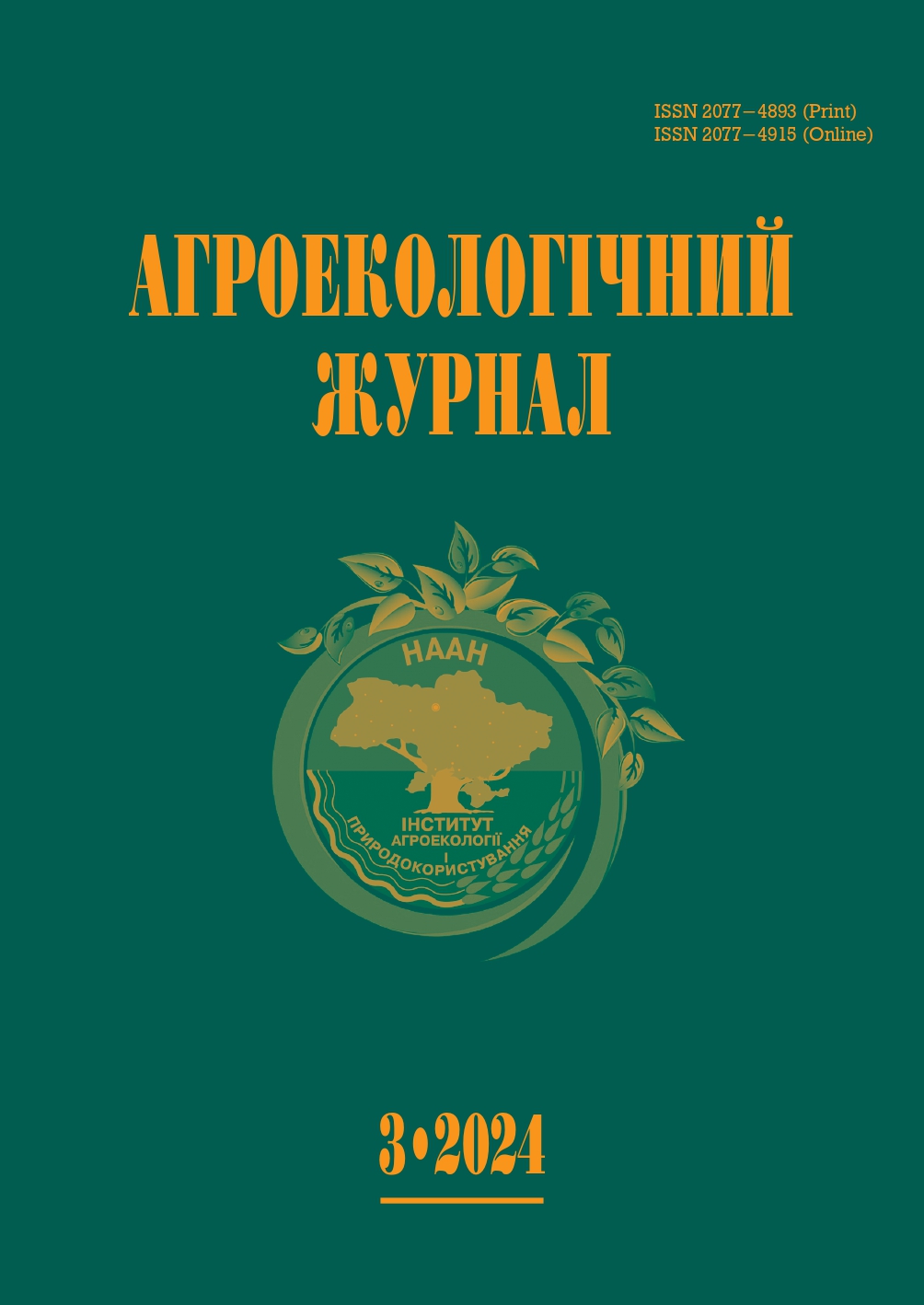Мікробні препарати для контролю чисельності фітофагів: механізми дії та переваги застосування
DOI:
https://doi.org/10.33730/2077-4893.3.2024.311186Ключові слова:
біопрепарати, пестициди, біоінсектициди, ентамопатогени, Bacillus thuringiensis, Streptomyces avermitilis, Beauveria, Metarhizium, інтегрований захист рослинАнотація
Широко відомо, що як основний метод регуляції чисельності фітофагів, у переважній більшості, використовуються саме синтетичні інсектициди. Однак, через швидко виникаючу резистентність до них, інсектициди є неефективними. Майже всі синтетичні препарати для захисту рослин від шкідливих комах є високотоксичними та повільно розкладаються в агроценозах і ґрунті, що завдає постійної і неминучої шкоди навколишньому середовищу. Відомо, що всі сучасні агротехнології вирощування сільськогосподарських культур включають застосування альтернативних екологічно безпечних методів контролю комах фітофагів за допомогою біопрепаратів. На користь цього свідчить прогресивна позитивна динаміка розвитку світового ринку біопестицидів. У цьому огляді продемонстровано екологічно безпечні та дієві шляхи контролю чисельності фітофагів за допомогою біопрепаратів. Описано особливості цих препаратів залежно від їх природи — бактеріальної, грибної та вірусної. Охарактеризовано основних представників продуцентів біопрепаратів, їх механізми дії на шкідливих комах, а також переваги та особливості в застосуванні. Детально розкрито механізм дії препаратів на основі Bacillus thuringiensis та показано можливість використання цього мікроорганізму для створення стійких до фітофагів ГМ-культур рослин. Визначено основи механізму дії ентомопатогенних грибів на фітофагів і схема зараження, розмноження та їх розповсюдження. Відзначено, що саме ентомопатогенні віруси, серед усіх ентомопатогенних мікроорганізмів є найбільш специфічними. Їм притаманна надзвичайна вибірковість патогенної дії, тобто здатність уражувати один або декілька видів членистоногих без шкоди для інших. Ця їх особливість є гарантією безпеки для нецільових організмів, незважаючи на те, що вони є успішними у боротьбі з фітофагами, їх складність у масовому виробництві та легка втрата властивостей у навколишньому середовищі робить їх менш поширеними серед аграріїв. Також показана важливість інтеграції різних методів боротьби проти комах шкідників та комбінації багатьох біопрепаратів для отримання максимальних врожаїв під час екологічно чистого вирощування рослин.
Посилання
Fedorenko, V.P., Mostoviak, S.M. & Mostoviak, I.I. (2021). Ekolohichno bezpechni metody kontroliu chyslennosti shkidnykiv u suchasnykh ahrotekhnolohiiakh [Ecologically safe methods of controlling the number of pests in modern agricultural technologies]. Ahroekolohichnyi zhurnal — Agroecological journal, 4, 64–74. DOI: https://doi.org/10.33730/2077-4893.4.2021.252957 [in Ukrainian].
Dhuldhaj, U.P., Singh, R. & Singh, V.K. (2023). Pesticide contamination in agro-ecosystems: toxicity, impacts, and bio-based management strategies. Environmental Science and Pollution Research., 30 (4), 9243–9270. DOI: https://doi.org/10.1007/s11356-022-24381-y [in English].
Fomenko, O.O. (2023). Otsinka khimichnykh preparativ dlia zakhystu yabluni vid shkidnykiv za ekotoksykolohichnymy pokaznykamy [Еvaluation of chemical preparations for apple tree protection against pests according to ecotoxicological indicators]. Ahroekolohichnyi zhurnal — Agroecological journal, 3, 116–127. DOI: https://doi.org/10.33730/2077-4893.3.2023.287770 [in Ukrainian].
Sinha, K.K., Choudhary, A.K., Kumari, P. & Omkar (Ed.). (2016). Entomopathogenic fungi. Ecofriendly pest management for food security. (рр. 475–505). DOI: https://doi.org/10.1016/B978-0-12-803265-7.00015-4 [in English].
Gunchak, M.V. Biolohichnyy metod zakhystu yabluni proty zelenoyi yablunevoyi popelytsi [Biological method of apple tree protection against green apple aphid]. «ΛΌГOΣ»: Collection of Scientific Papers. (рр. 120–123). Cambridge, United Kingdom. DOI: https://doi.org/10.36074/logos-20.05.2022.036 [in Ukrainian].
Borzykh, O.I., Bublyk L.I., Hunchak M.V. et al. (2023). Ekotoksykolohichni parametry zastosuvannia biopestytsydiv, rozrobka ta adaptatsiia biolohichnykh system zakhystu yabluni vid shkidnykiv ta khvorob do gruntovoklimatychnykh umov ta fitosanitarnoho stanu ahrotsenozu [Ecotoxicological parameters of the use of biopesticides, development and adaptation of biological systems for the protection of apple trees from pests and diseases to soil and climatic conditions and the phytosanitary state of the agrocenosis]. Fitosanitarna bezpeka — Phytosanitary safety, 68, 3–26. DOI: https://doi.org/10.36495/1606-9773.2022.68.3-26 [in Ukrainian].
Mostoviak, І.І., Demyanyuk, O.S. & Lisovyy, M.M. (2020). Ekolohichna struktura shkidlyvoho entomokompleksu ahrotsenoziv zernovykh zlakovykh kul’tur tsentral’noho lisostepu ukrayiny [Ecological structure of harmful entomocomplex of agrocenoses of cereals culture of the central forest steppe of Ukraine]. Ahroekolohichnyi zhurnal — Agroecological journal, 2, 31–39. DOI: https://doi.org/10.33730/2077-4893.2.2020.207678 [in Ukrainian].
Stahly, D.P., Andrews, R.E. & Yousten, A.A. (2006). The genus Bacillus–Insect pathogens. Prokaryotes, 4, 563–608. DOI: https://doi.org/10.1007/0-387-30744-3_17 [in English].
Sharma, L., Bohra, N., Singh, R.K., Marques, G., Khan, M. & Ahmad, W. (Eds.). (2019). Potential of entomopathogenic bacteria and fungi. Microbes for Sustainable Insect Pest Management. Sustainability in Plant and Crop Protection. Cham. DOI: https://doi.org/10.1007/978-3-030-23045-6_4 [in English].
Tarusikirwa, V.L., Machekano, H., Mutamiswa, R., Chidawanyika, F. & Nyamukondiwa, C. (2020). Tuta absoluta (Meyrick) (Lepidoptera: Gelechiidae) on the «Offensive» in Africa: Prospects for Integrated Management Initiatives. Insects, 11, 764. DOI: https://doi.org/10.3390/insects11110764 [in English].
Thakur, N., Tomar, P., Kaur, S., Jhamta, S. & Ajar, Nath Yadav (Ed.). (2021). Entomopathogenic soil microbes for sustainable crop protection. Soil microbiomes for sustainable agriculture: functional annotation. Sustainable Development and Biodiversity. (рр. 529–571). Springer. DOI: https://doi.org/10.1007/978-3-030-73507-4_17 [in English].
Adepeju, D.M., Uwanta, L.I., Agu, K.C. et al. (2023). Mosquito larvae biocontrol potential of Bacillus thuringiensis isolated from soil samples. International Journal of Research Publication and Reviews, 4 (8), 1899–1906. URL: https://www.researchgate.net/publication/373237930_Mosquito_Larvae_Biocontrol_Potential_of_Bacillus_Thuringiensis_Isolated_from_Soil_Samples [in English].
Astuto, M.C. & Cattaneo, I. (2024). Bacillus thuringiensis. Encyclopedia of Toxicology (Fourth Edition), 1, 893–901. DOI: https://doi.org/10.1016/B978-0-12-824315-2.00491-7 [in English].
Bravoa, A., Likitvivatanavongb, S., Gillb, S.S. & Soberóna, M. (2011). Bacillus thuringiensis: A story of a successful bioinsecticide. Insect. Biochem. Mol. Biol., 41 (7), 423–431. DOI: https://doi.org/10.1016/j.ibmb.2011.02.006 [in English].
Gu, J., Ye, R., Xu, Y. et al. (2021). A historical overview of analysis systems for Bacillus thuringiensis (Bt) Cry proteins. Microchemical Journal, 165, 106137. DOI: https://doi.org/10.1016/j.microc.2021.10613 [in English].
Sherstoboieva, O.V., Kryzhko, A.V. & Kuznietsova, L.M. (2010). Ekolohichni aspekty zastosuvannia Bacillus thuringiensis u systemi zakhystu kartopli vid koloradskoho zhuka [Ecological aspects of the use of Bacillus thuringiensis in the potato protection system against the Colorado potato beetle]. Ahroekolohichnyi zhurnal — Agroecological journal, 3, 234–236 [in Ukrainian].
Schwenk, V., Riegg, J., Lacroix, M., Märtlbauer, E. & Jessberger, N. (2020). Enteropathogenic Potential of Bacillus thuringiensis Isolates from Soil, Animals, Food and Biopesticides. Foods, 9 (10), 1484. DOI: https://doi.org/10.3390/foods9101484 [in English].
Mora, M.A.E., Castilho, A.M.C. & Fraga, M.E. (2017). Classification and infection mechanism of entomopathogenic fungi. Arquivos do Instituto Biológico, 84, 1–10. DOI: https://doi.org/10.1590/1808-1657000552015 [in English].
Dinkwar, G.T. & Ashwini, E. (2022). Entomopathogenic fungi: need of sustainable agriculture. Biotica Research Today, 4 (10), 657–661. URL: https://www.biospub.com/index.php/biorestoday/article/view/1679 [in English].
Sandhu, S.S., Shukla, H., Aharwal, R.P., Kumar, S., Shukla, S. & Panpatte, D. et al. (Eds.). (2017). Efficacy of entomopathogenic fungi as green pesticides: current and future prospects. Microorganisms for Green Revolution. Microorganisms for Sustainability. Singapore. DOI: https://doi.org/10.1007/978-981-10-6241-4_17 [in English].
Altinok, H.H., Altinok, M.A. & Koca, A.S. (2019). Modes of action of entomopathogenic fungi. Current Trends in Natural Sciences, 8 (16), 117–124. URL: https://www.researchgate.net/publication/338390298_Modes_of_Action_of_Entomopathogenic_Fungi#fullTextFileContent [in English].
Bava, R., Castagna, F., Piras, C. et al. (2022). Entomopathogenic fungi for pests and predators control in beekeeping. Veterinary Sciences, 9 (2), 95. DOI: https://doi.org/10.3390/vetsci9020095 [in English].
Zekeya, N., Chacha, M., Ndakidemi, P.A. et al. (2017). Tomato Leafminer (Tuta absoluta Meyrick 1917). A threat to Tomato production in Africa. Journal of Agriculture and Ecology Research International, 10, 1–10. DOI: https://doi.org/10.9734/JAERI/2017/28886 [in English].
Raj, M.N., Samal, I., Paschapur, A. Subbanna, A.R.N.S. & Harikesh Bahadur, Singh et al. (Eds.). (2022). Entomopathogenic viruses and their potential role in sustainable pest management. New and Future Developments in Microbial Biotechnology and Bioengineering. (рр. 47–72). DOI: https://doi.org/10.1016/B978-0-323-85579-2.00015-0 [in English].
Reid, S., Malmanche, H., Chan, L., Popham, H., Van Oers, M.M. & Juan A., Morales-Ramos et al. (Eds.). (2023). Production of entomopathogenic viruses. Mass Production of Beneficial Organisms (Second Edition). (рр. 375–406). DOI: https://doi.org/10.1016/B978-0-12-822106-8.00020-8 [in English].
Deka, B., Baruah, C. & Babu, A. (2021). Entomopathogenic microorganisms: their role in insect pest management. Egyptian Journal of Biological Pest Control., 121 (31). DOI: https://doi.org/10.1186/s41938-021-00466-7 [in English].
Biondi, A., Guedes, R.N.C., Wan F.-H. & Desneux, N. (2018). Ecology, worldwide spread, and management of the invasive south american Tomato pinworm, Tuta absoluta: past, present, and future. Annual Review of Entomology, 63, 239–258. DOI: https://doi.org/10.1146/annurev-ento-031616-034933 [in English].
Silva, G.A., Picanco, M.C., Bacci, L. et al. (2011). Control failure likelihood and spatial dependence of insecticide resistance in the tomato pinworm, Tuta absoluta. Pest Management Science, 67, 913–920. DOI: https://doi.org/10.1002/ps.2131 [in English].
Bala, I., Mukhtar, M., Saka, H., Abdullahi, N. & Ibrahim, S. (2019). Determination of insecticide susceptibility of field populations of tomato leaf miner (Tuta absoluta) in Northern Nigeria. Agriculture, 9 (1), 7. DOI: https://doi.org/10.3390/agriculture9010007 [in English].
Birhan, A. (2018). Tomato leafminer [(Tuta absoluta Meyrick) (Lepidoptera: Gelechiidae)] and its current ecofriendly management strategies: A review. Journal of agricultural biotechnology and sustainable development, 10, 11–24. DOI: https://doi.org/10.5897/JABSD2018.0306 [in English].
Harish, S., Murugan, M., Kannan, M. et al. (2021). Entomopathogenic viruses. Microbial Approaches for Insect Pest Management. Singapore. DOI: https://doi.org/10.1007/978-981-16-3595-3_1 [in English].
##submission.downloads##
Опубліковано
Номер
Розділ
Ліцензія
Авторське право і ліцензування
Умови ліцензії: автори зберігають авторські права і надають журналу право першої публікації з роботою, одночасно ліцензованої за ліцензією Creative Commons Attribution License International CC-BY, яка дозволяє іншим ділитися роботою з визнанням авторства роботи і початкової публікації в цьому журналі.
Якщо стаття прийнята до публікації в «Агроекологічний журнал», автор повинен підписати угоду про передачу авторських прав. Угода відправляється на поштову (оригінал) або адресу електронної пошти (відсканована копія) редакції журналу.
Цією угодою автор підтверджує, що представлені матеріали:
- не порушують авторських прав інших осіб або організацій;
- раніше не публікувались в інших видавництвах і не були представлені для публікації в інших виданнях.
Автор передає редакції «Агроекологічного журналу» права на:
- публікації статті українською (англійською) мовою і поширення її друкованої копії;
- поширення електронної копії статті, а також електронної копії перекладу статті на англійську мову (для статей українською мовою), будь-якими електронними засобами (розміщення на офіційному сайті журналу, електронних баз даних, сховищ тощо) друкована копія перекладу.
Автор залишає за собою право без згоди редакції та засновників:
- Використовувати матеріали статті повністю або частково в ознайомлювальних цілях.
- Використовувати матеріали статті повністю або частково для написання власних дисертацій.
- Використовувати матеріали статті для підготовки тез доповідей, доповідей конференцій, а також усних доповідей.
- Додати електронні копії статті (включаючи остаточну електронну копію, завантажену з офіційного сайту журналу) за адресою:
- персональні веб-ресурси всіх авторів (веб-сайти, веб-сторінки, блоги тощо);
- веб-ресурси установ, в яких працюють автори;
- некомерційні веб-ресурси відкритого доступу (наприклад, arXiv.org).
У всіх випадках наявність бібліографічного посилання на статтю або гіперпосилання на її електронну копію на офіційному сайті журналу є обов'язковим.



